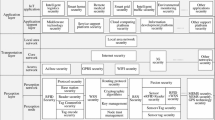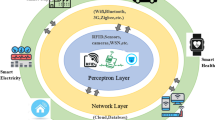Abstract
Radio frequency identification (RFID) technology will become one of the most popular technologies to identify objects in the near future. However, the major barrier that the RFID system is facing presently is the security and privacy issue. Recently, a lightweight anti-desynchronization RFID authentication protocol has been proposed to provide security and prevent all possible malicious attacks. However, it is discovered that a type of desynchronization attacks can successfully break the proposed scheme. To overcome the vulnerability under the desynchronization attacks, we propose a low-cost RFID authentication protocol which integrates the operation of the XOR, build-in CRC-16 function, permutation, a random tuple and secret key backup technology to improve the security functionality without increasing any cost than the utralightweight protocols. The analysis shows that our proposal has a strong ability to prevent existing malicious attacks, especially the desynchronization attacks.








Similar content being viewed by others
References
Juels, A. (2006). RFID security and privacy: A research survey. IEEE Journal on Selected Areas in Communications, 24(2), 381–394.
Sun, H. M., & Ting, W. C. (2009). A Gen2-based RFID authentication protocol for security and privacy. IEEE Transactions on Mobile Computing, 8(8), 1052–1062.
Sarma, S. E., Weis, S. A., & Engels, D. W. (2003). Radio-frequency identification: Secure risks and challenges. RSA Laboratories Cryptobytes, 6(1), 2–9.
Weis, S. A. (2003). Security and privacy in radio-frequency identification devices. Massachusetts Institute of Technology.
Juels, A., Rivest, R. L., & Szydlo, M. (2003). The Blocker Tag: Selective blocking of RFID tags for consumer privacy. In Proceedings of the l0th ACM conference of computer and communications security (pp. l03–111).
Chien, H. Y. (2007). SASI: A new ultralightweight RFID authentication protocol providing strong authentication and strong integrity. IEEE Transaction of Dependable and Secure Computing, 3(4), 337–340.
Sarma, S. E., Weis, S. A., & Engels, D. W. (2003). RFID systems and security and privacy implications. In Proceedings of the 4th international workshop on cryptographic hardware and embedded systems (pp. 454–469).
Henrici, D., & Muller, P. (2004). Hash-based enhancement of location privacy for radio-frequency identification devices using varying identifiers. In Proceedings of 2nd IEEE annual conference on pervasive computing and communications workshops (pp. 149–153).
Gao, L., Ma, M., Shu, Y., & Wei, Y. (2013). A security protocol resistant to intermittent position trace attacks and synchronization attacks in RFID systems. Wireless Personal Communications, 68(4), 1943–1959.
Zhou, S., Zhang, Z., & Luo, Z. (2010). A lightweight anti-desynchronization RFID authentication protocol. Information Systems Frontiers, 12(5), 521–528.
Blurn, A., Furst, M., & Keams, M. (1993). Cryptographie primitives based on hard leaming problems. Advances in Cryptology-CRYPTO, 773(1993), 1–10.
Juels, A., & Weis, S. A. (2005). Authenticating pervasive devices with human protocols. Advances in Cryptology-CRYPTO, 3621(2005), 293–308.
Bringer, J., Chabanne, H., & Dottax, E. (2006). HB++: A lightweight authentication protocol secure against some attacks. In Proceedings of IEEE international conference on pervasive services workshop on security (pp. 28–33).
Piramuthu, S. (2007). HB and related lightweight authentication protocols for secure RFID tag/reader authentication. In Proceedings of the CollECTeR (Europe) conference (pp. 1–8).
Duc, D. N., Park, J., Lee, H., & Kim, K. (2006). Enhancing security of EPCglobal Gen-2 RFID tag against traceability and cloning. White Paper, pp. 1–11.
Doss, R., Saravanan, S., & Zhou, W. L. (2012). A practical quadratic residues based scheme for authentication and privacy in mobile RFID systems. Ad Hoc Networks, 11(1), 383–396.
Doss, R., Zhou, W. L., Saravanan, S., Yu, S., & Gao, L. X. (2012). A minimum disclosure approach to authentication and privacy in RFID systems. Computer Networks, 56(15), 3401–3416.
Lopez, P. P., & Castro, J. H. (2006). \(\text{ M }^{2}\text{ AP }\): A minimalist mutual-authentication protocol for low-cost RFID tags. In Proceedings of the international conference on ubiquitous intelligence and computing (pp. 912–923).
Bárász, M., Boros, B., & Lója, P. L. K. (2007). Passive attack against the \(\text{ M }^{2}\text{ AP }\) mutual authentication protocol for RFID tags. In Proceedings of the first international workshop on RFID technology (pp. 1–4).
Sun, H. M., Ting, W. C., & Wang, K. H. (2011). On the security of Chien’s ultralightweight RFID authentication protocol. IEEE Transaction Dependable and Secure Computing, 8(2), 315–317.
Peris-Lopez, P., Hernandez-Castro, J. C., & Tapiador, J. M. E. (2009). Advances in ultralightweight cryptography for low-cost RFID tags: Gossamer protocol. In Proceedings of the 9th international workshop on information security applications (pp. 56–68).
Ahmed, E. G., Shaaban, E., & Hashem, M. (2010). Lightweight mutual authentication protocol for low cost RFID tags. Journal of Network and Computer Applications, 2(2), 27–37.
Tian, Y., Chen, G. L., & Li, J. H. (2012). A new ultralightweight RFID authentication protocol with permutation. IEEE Communications Letters, 16(5), 702–705.
Gao, L., Ma, M., Shu, Y., & Wei, Y. (2014). An ultralightweight RFID authentication protocol with CRC and permutation. Journal of Network and Computer Applications, 41(5), 37–46.
Paolo, D., & Santis, A. D. (2011). On ultralightweight RFID authentication protocols. IEEE Transactions on Dependable and Secure Computing, 8(4), 548–563.
Avoine, G., Carpent, X., & Martin, B. (2012). Privacy-friendly synchronized ultralightweight authentication protocols in the storm. Journal of Network and Computer Applications, 35(2), 826–843.
Acknowledgments
This work was partially supported by the National Natural Science Foundation of China (NSFC) under Grant No. 61202379 and Natural Science Foundation of Liaoning Province under Grant No. 2013024020.
Author information
Authors and Affiliations
Corresponding author
Rights and permissions
About this article
Cite this article
Gao, L., Ma, M., Shu, Y. et al. A Low-Cost RFID Authentication Protocol Against Desynchronization with a Random Tuple. Wireless Pers Commun 79, 1941–1958 (2014). https://doi.org/10.1007/s11277-014-1966-x
Published:
Issue Date:
DOI: https://doi.org/10.1007/s11277-014-1966-x




